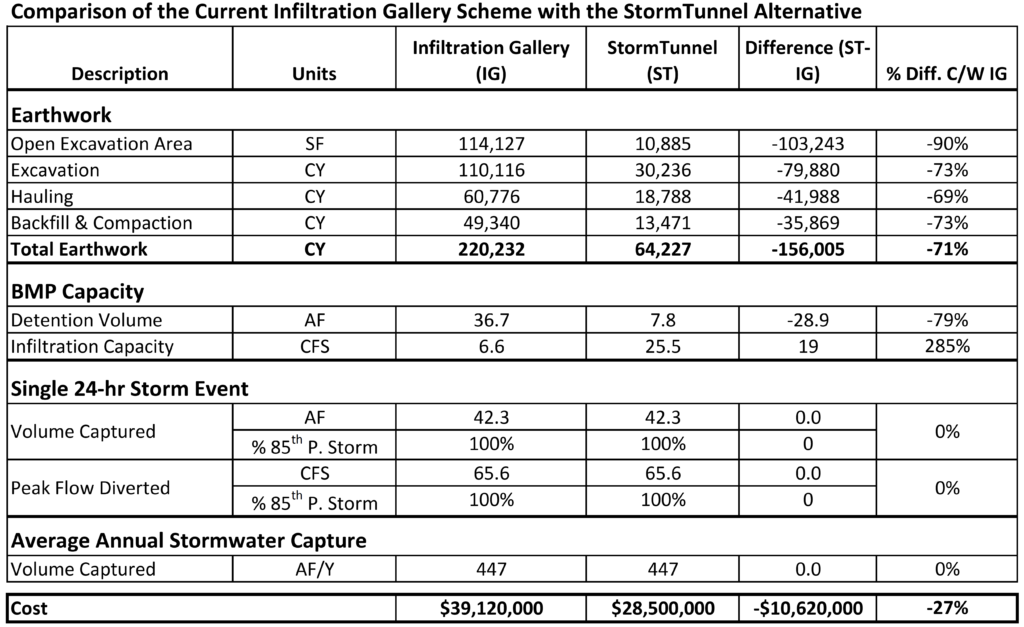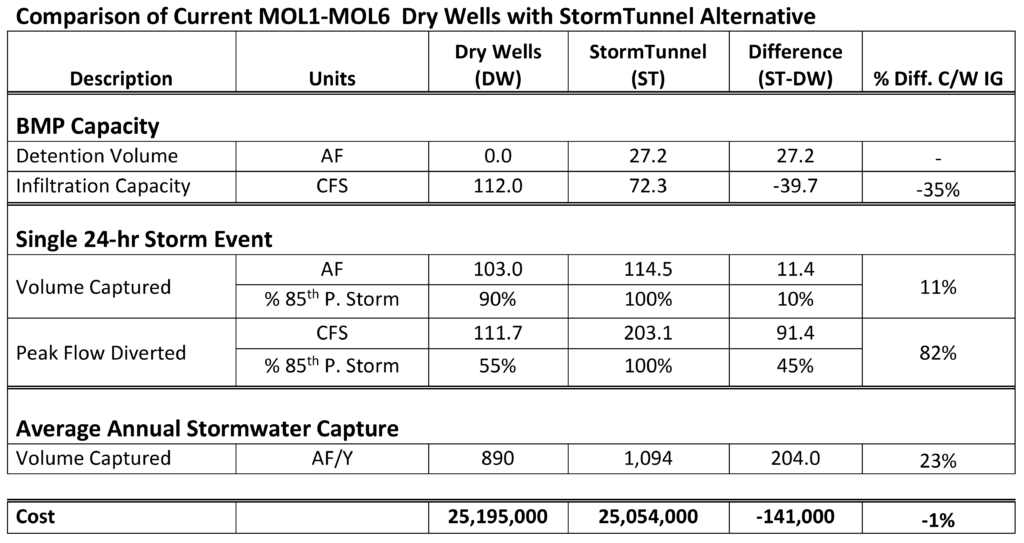Huntington Drive Regional Green Street Project, City of South Pasadena, California
PROJECTS
The City of South Pasadena has selected StormTunnel for its "Huntington Drive Regional Green Street Project and retained SEITec to prepare the project preliminary design. The City is also working with SEITec to complete the project feasibility study and hydrology/hydraulic modeling to apply for the County of Los Angeles Safe, Clean, Water Program grant for project funding. The City has already secured $1.0 Million funding from the Metropolitan Water District Stormwater Recharge Program for the project.
Currently work on the geotechnical investigations to prepare the project Geotechnical Basis Report, plus work on Phase-II environmental studies is being performed by other consultants. The geotechnical studies include deep drywell infiltration testing, which will be used in the hydrology/hydraulic modeling studies to finalized the number and depth of project drywells.
Project Feasutres:
The project is a StormTunnel BMP system consist of the following elements:
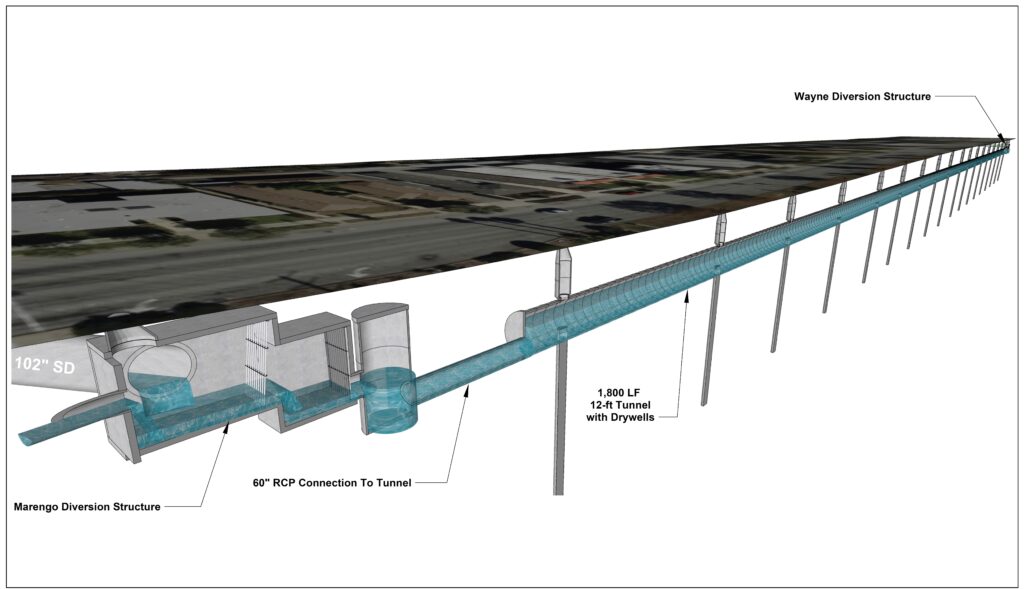
- Two stormwater diversion facilities on County storm drains
- 1800 LF of 12-ft Diameter tunnel with drywells to replenish the Central Basin Aquifer and to store water locally for landscape irrigation
- Huntington Dr. “Green Streets” landscaping with parkway bioswales & enhancements
- Landscaping and new trees in median and parkways for carbon sequestration
- Solar pumps and controls for irrigation of landscaped parkways and trees using stored stormwater
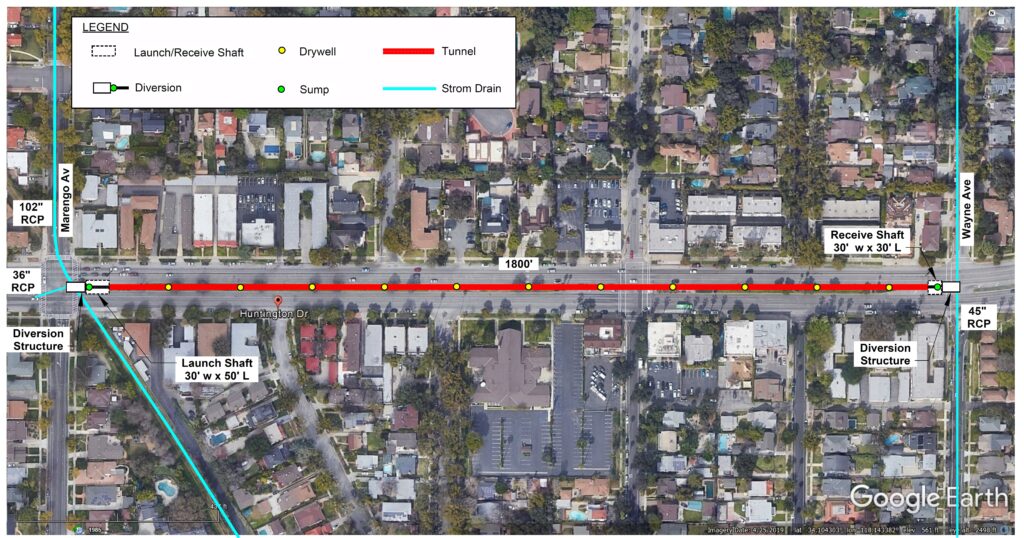
![]()
![]()
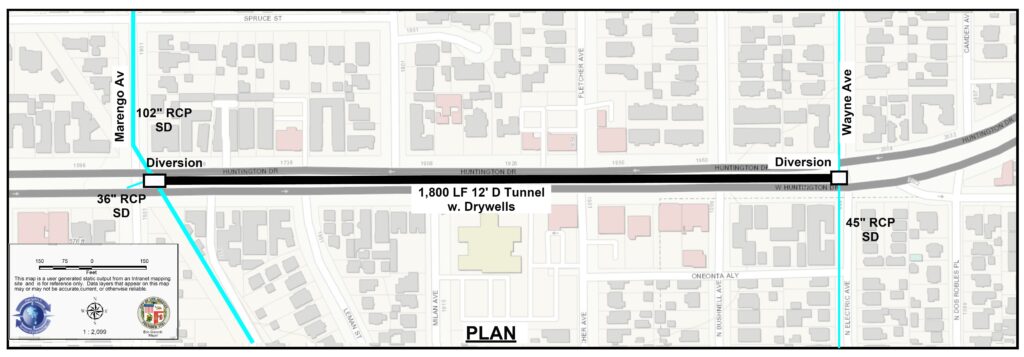
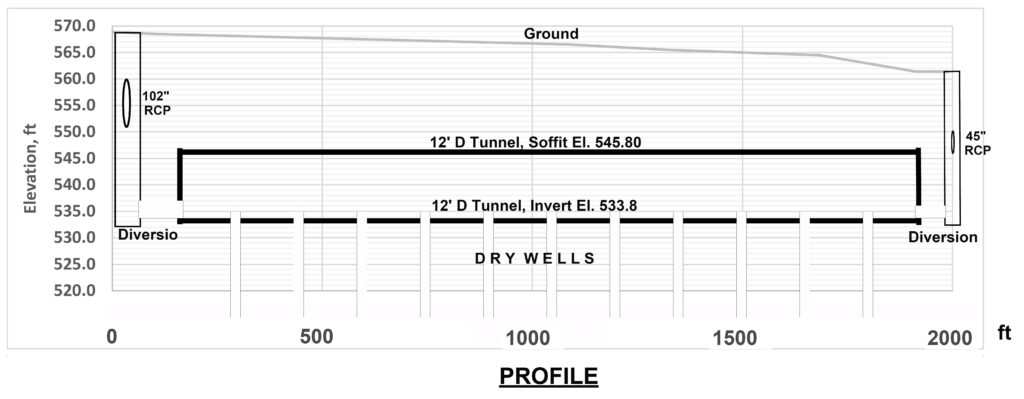
PROPOSALS
As the parent company of StormTunnel, SEITec has submitted four unsolicited, firm-cost, design-build proposals for stormwater projects that are currently in conceptual design phase using conventional Best Management Practices. The current schemes for the first project is comprised of clusters of drywells at 7 locations along a dedicated public transport bus line. The current scheme for the other three projects are underground detention/infiltration galleries in public parks.
The significant cost savings and greatly reduced public impact of the StormTunnel Alternative in all four projects demonstrate its tremendous game-changing benefits.
Metro Orange Line a Water Infiltration and Quality Project, Los Angeles County Metropolitan Transportation Authority
Current Scheme:
The current BMP scheme consists of seven (7) cluster of drywells along the Metro Orange Line over a distance of about 2 miles. Each drywell cluster is located in the immediate vicinity of their respective storm drains that they serve and consists of the following elements.
- Diversion structure in the form of sloping apron and side outlet
- Diversion pipe
- Pump station
- Detention facility for pretreatment
- Conveyance pipe to individual drywells
See Current Scheme Feasibility Study Report
Proposed StormTunnel Alternative:
The proposed StormTunnel BMP consist of a single 12-ft ID tunnel with its centerline directly under the planter separating the bus line from the bike path. It stretches a distance of 7,950 LF (1.5 Miles) from Kester Ave (MOL-1) to Woodman Ave (MOL-6) under all existing utility lines and storm drains. The tunnel incorporates 90 drywells spaced at 50-ft intervals along its centerline with access shafts directly above along the planter centerline. As such it does not disrupt the operation of the bus line during construction.
SEITec submitted the proposed StormTunnel BMP to the Metro Office of Extraordinary Innovation and received favorable response. It an official letter, Metro "...encouraged SEITec to keep apprised of the G Line (Orange) Improvements Project competitive solicitation and to reach out to the eventually selected contractor to present their concept as an alternative approach."
The StormTunnel provides detention volume and connectivity between the drywells. It eliminates all surface trenching and piping to the drywells, which in the current scheme cross the bus line at many locations. The scheme reduces the number of drywells required from 140 to 90, all located along a single alignment in the planter.
The intake of the drywells inside the tunnel are raised by 1.5 feet to provide 55,000 CF of retention volume, which eliminates the need for the proposed StormTrap facilities of the current scheme at each drywell cluster. The tunnel could be bored using recently developed surface-launch-and-receive tunnel boring machine technology, which eliminates the need for the launch and receive shafts. The combined effect is significantly less excavations and overall impact during construction.
Advantages of the StormTunnel Alternative:
The proposed StormTunnel Alternative offers the following advantages over the current scheme:
- Eliminates open excavated pre treatment facilities
- Provides 27.2 AF of detention volume versus zero
- Captures 100% of 85th P. Storm vol. of 114.5 AF vs. 90% (103 AF)
- Captures 100% of 85th P. Storm peak of 203 cfs vs. 55% (112 cfs)
- Captures av. of 1,094 AF/YR vs. 890 AF/YR (240 AF, 23%) more
- Minimum public impact because of reduced open excavation
- Minimal electrical work vs. extensive scope for six pump stations
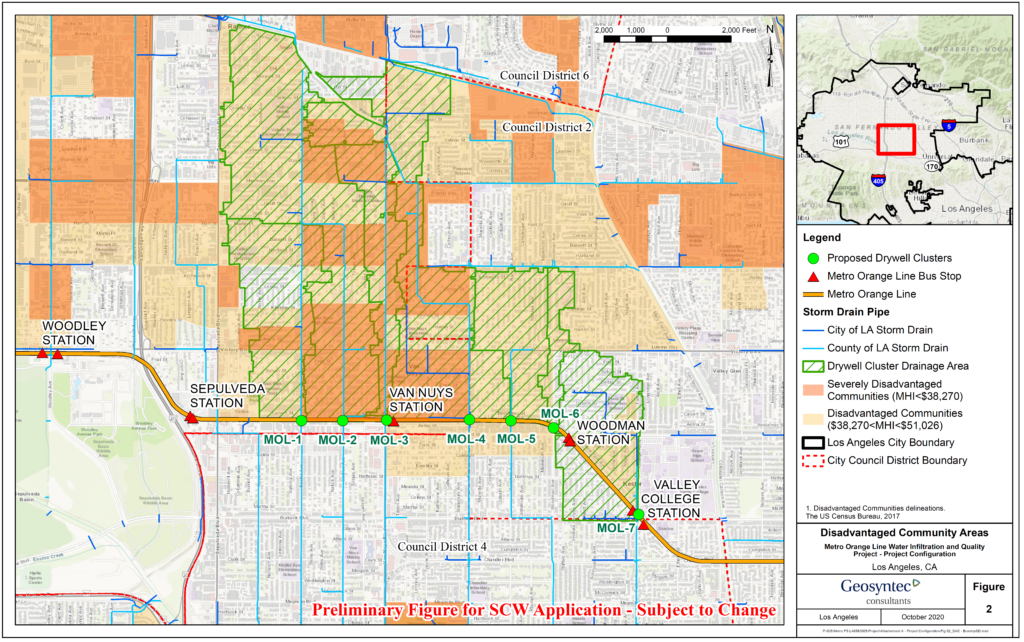
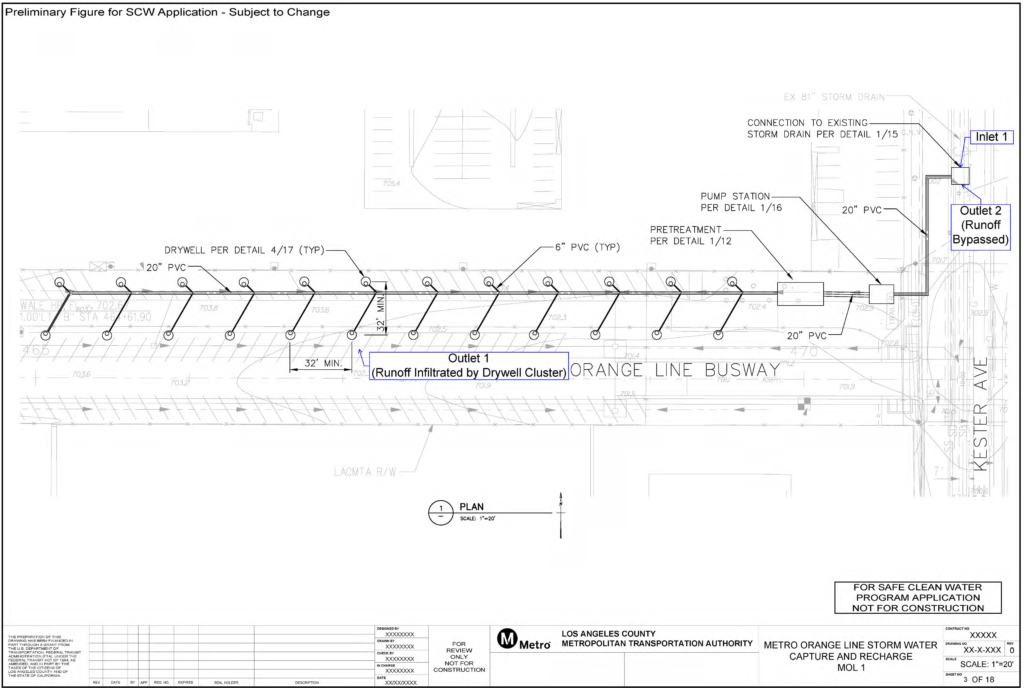
Current Scheme Plan and Dry Well Cluster 1 of 7 Details
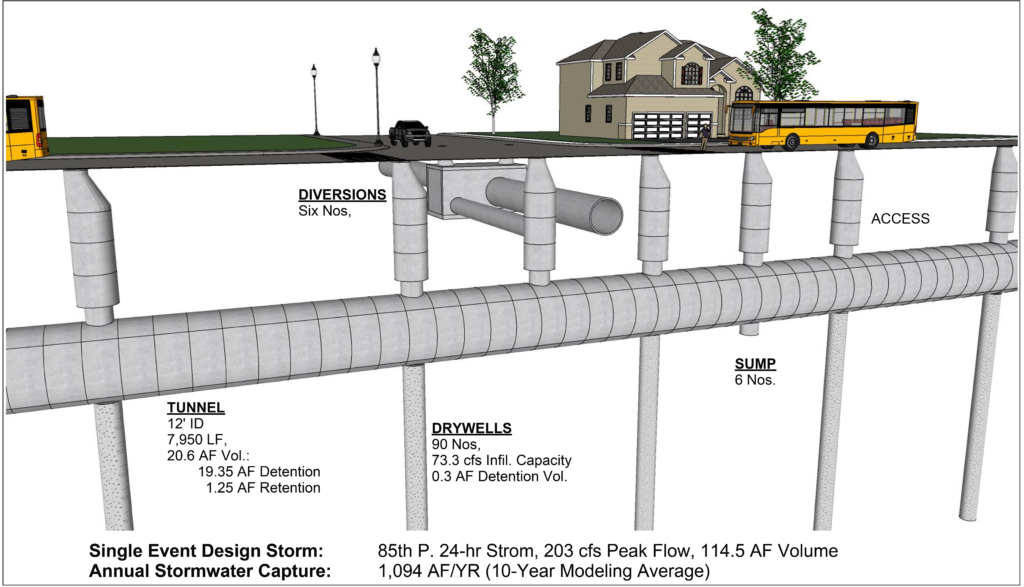
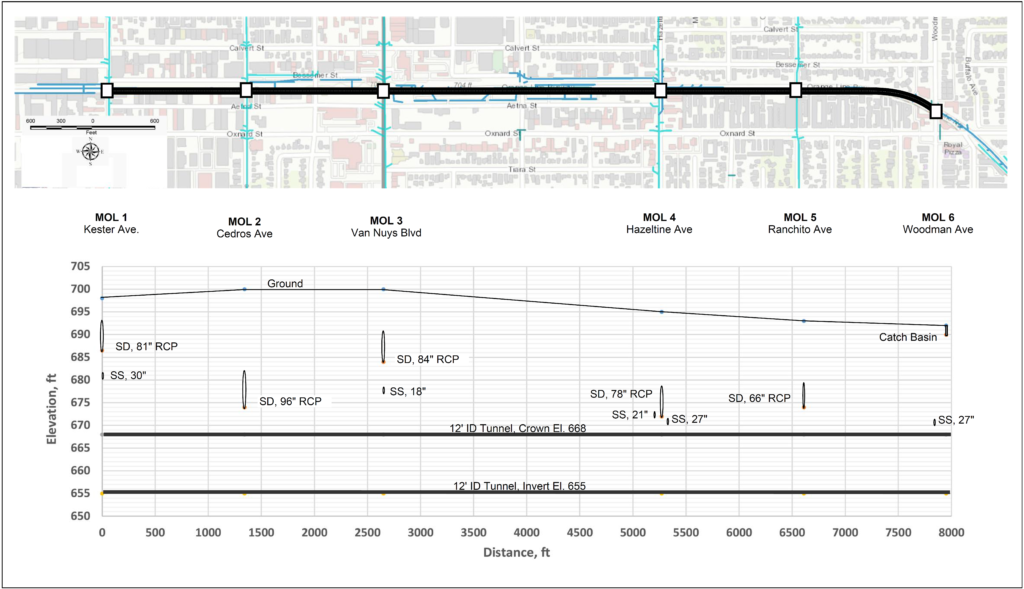
Proposed StormTunnel Alternative Replacing 6 of 7 Dry Well Clusters
Project cost is about the same for both alternatives
North Hollywood Park Stormwater Capture Project, Los Angeles Department of Water and Power
Current Scheme:
The current North Park BMP scheme consists of the following elements:
- One diversion structure with side outlet on existing box culvert storm drain.
- Actuated slide gate and trash rack following the diversion structure.
- One hydrodynamic separator following the trash rack.
- One sedimentation basin d/s of the hydrodynamic separator.
- Two infiltration basins connected via an equalization pipe with total area of 2.4 acres
The current South Park BMP scheme consists of the following elements:
- One diversion structure with grated drop inlet and d/s rubber dam
- A 36” reinforced concrete pipe (RCP) for gravity diversion
- One hydrodynamic separator following the diversion structure
- One sedimentation basin downstream of the hydrodynamic separator
- One subsurface infiltration gallery with area of 1.1 acres.
See Current Scheme Feasibility Study Report
Proposed StormTunnel Alternative:
The proposed StormTunnel BMP consist of the following elements:
- Single 165 cfs diversion structure with d/s rubber dam.
- RCP pipes to five parallel 12’ ID StormTunnels with 50-ft spaced alignments.
- 33 cfs Sediment filter with parallel hydrodynamic separators for each tunnel.
- Total combined StormTunnel length of 5,075 LF, with detention vol. of 13.9 AF.
- 88 embedded drywells at 50-ft spacing with infiltration capacity of 44 cfs.
See Valley Plaza StormTunnel Plans
Advantages of the StormTunnel Alternative:
The proposed StormTunnel Alternative offers the following advantages over the current scheme:
- Open excavation of about 10,500 SF versus 152,000 SF (93% less)
- Total earth work volume of about 84,000 CY versus 293,000 CY (82% less)
- Complete gravity solution with no pump stations, vs a 30 cfs pump station
- Captures 100% of 85th P. storm peak of 162 cfs, vs. 80 cfs (49%)
- Infiltrates 100% of the 85th P. storm volume of 74 AF, vs. 42 AF (56%)
- Captures average of 840 AF/YR versus 6502 AF/YR i.e. 190 AF (29%) more
- Design-Build schedule of two years vs. Design-Bid-Build schedule of 5 years
- Work is only in the south portion of the park vs. both north and south
- Practically no park closures versus complete closure of large areas
- Minimum public impact because of reduced excavation and earthwork
- Practically no electrical work versus extensive scope for a pump station
- No power demand and minimized carbon footprint vs year-round pumping
Project cost of $34.5 vs. $53.43 Million, ($18.93 Million, 35% less)
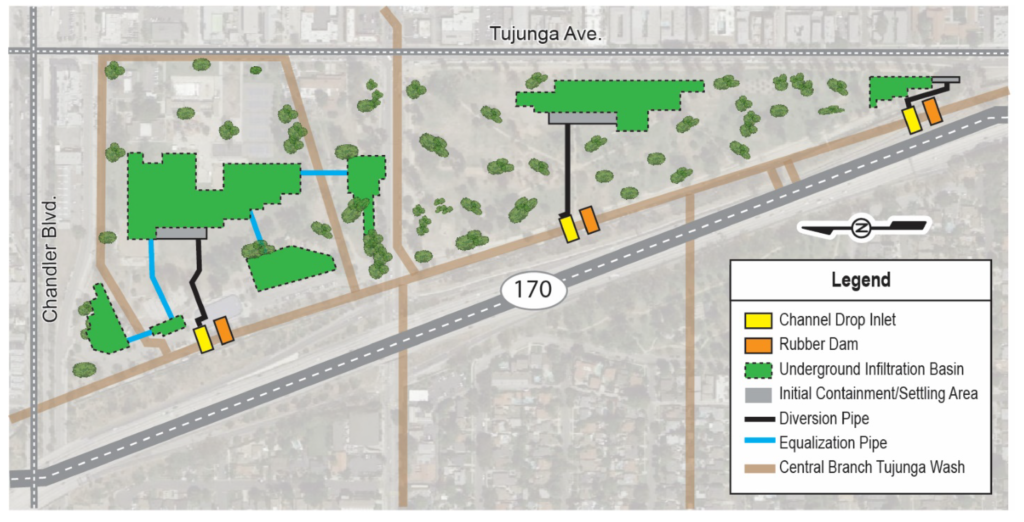 Current Scheme using Infiltration Galleries
Current Scheme using Infiltration Galleries
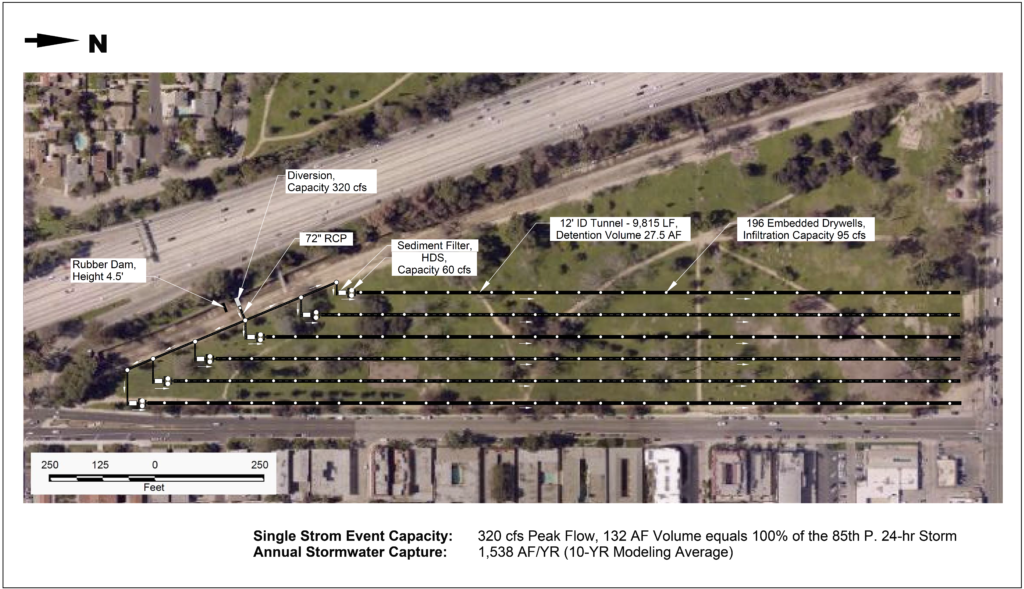
Proposed StormTunnel Alternative Plan
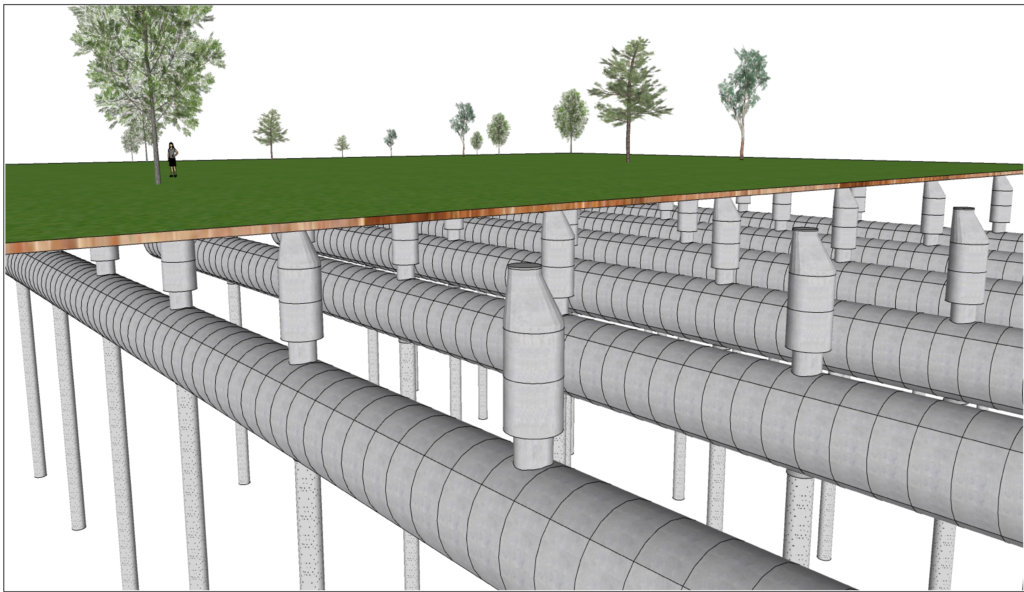
Proposed StormTunnel Alternative Perspective
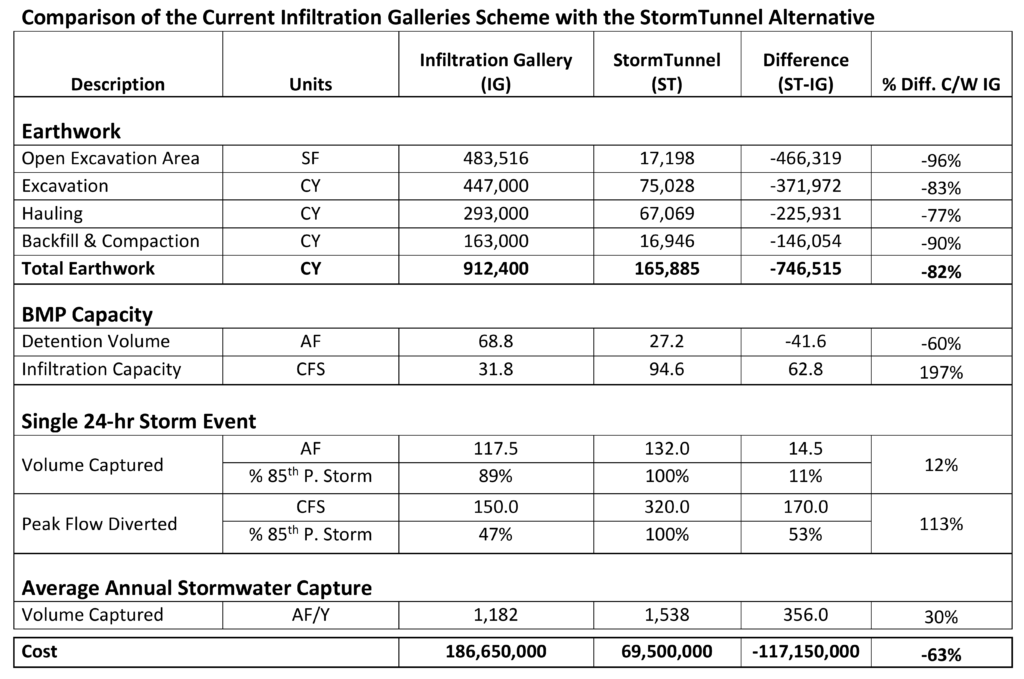
Valley Plaza Park Stormwater Capture Project, Los Angeles Department of Water and Power
Current Scheme:
The current best management practice (BMP) scheme consist of the following elements:
- Three 50 cfs capacity diversion structures via grated drop inlets and d/s rubber dams.
- Three infiltration galleries: 7.3, 3.2, and 0.6 acres (total 11.1 acres).
- Three pump stations, one upstream each infiltration gallery.
- Three sedimentation basins, one upstream of each pump station.
- Three hydrodynamic separators, one upstream of each sedimentation basin
See Current Scheme Feasibility Study Report
Proposed StormTunnel Alternative:
The proposed StormTunnel BMP consist of the following elements:
- Single 320 cfs diversion structure via grated channel bed and side with d/s rubber dam.
- RCP pipes to six parallel 12’ ID StormTunnels with 50-ft spaced alignments.
- 60 cfs Sediment filter with parallel hydrodynamic separators for each tunnel.
- Total combined StormTunnel length of 9,815 LF, with detention volume of 27.5 AF.
- 196 embedded drywells at 50-ft spacing with combined infiltration capacity of 95 cfs.
See North Hollywood Park StormTunnel Plans
Advantages of the StormTunnel Alternative:
The proposed StormTunnel Alternative offers the following advantages over the current scheme:
- Open excavation of about 17,200 SF versus 483,500 SF (96% less)
- Total earth work volume of about 165,000 CY versus 912,000 CY (82% less)
- Complete gravity solution with no pump stations, versus three 50 cfs pump stations
- Captures 100% of the 85th P. 24-hour storm peak of 320 cfs, versus 150 cfs (47% of peak)
- Infiltrates 100% of the 85th P. 24-hour storm volume of 132 AF, versus 117.5 AF (89%)
- Captures average of 1,538 AF/YR versus 1,182 AF/YR i.e. 362 AF (30%) more
- Design-Build schedule of about one year versus Design-Bid-Build schedule of about 5 years
- Work is only in the south portion of the park versus both north and south
- Practically no park closures during construction versus complete closure of large areas
- Minimum public impact during construction because of reduced open excavation and earthwork quantities
- Practically no electrical work versus extensive electrical work for three 130 hp pump stations
- No power consumption and minimized carbon footprint versus year-round pumping
Project cost of $69.5 vs. $186.65 Million ($117 Million, 63% less)
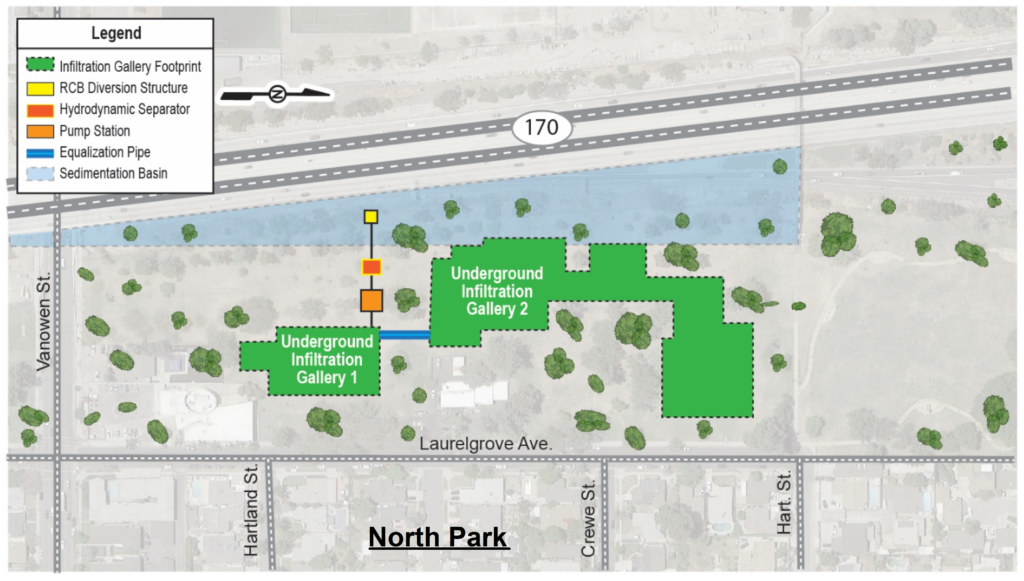
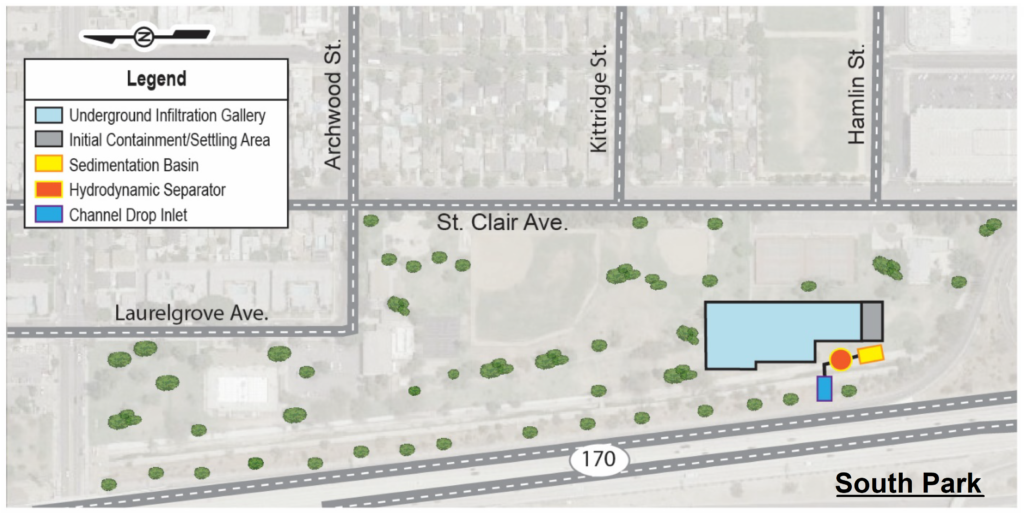
Current Scheme using Infiltration Galleries
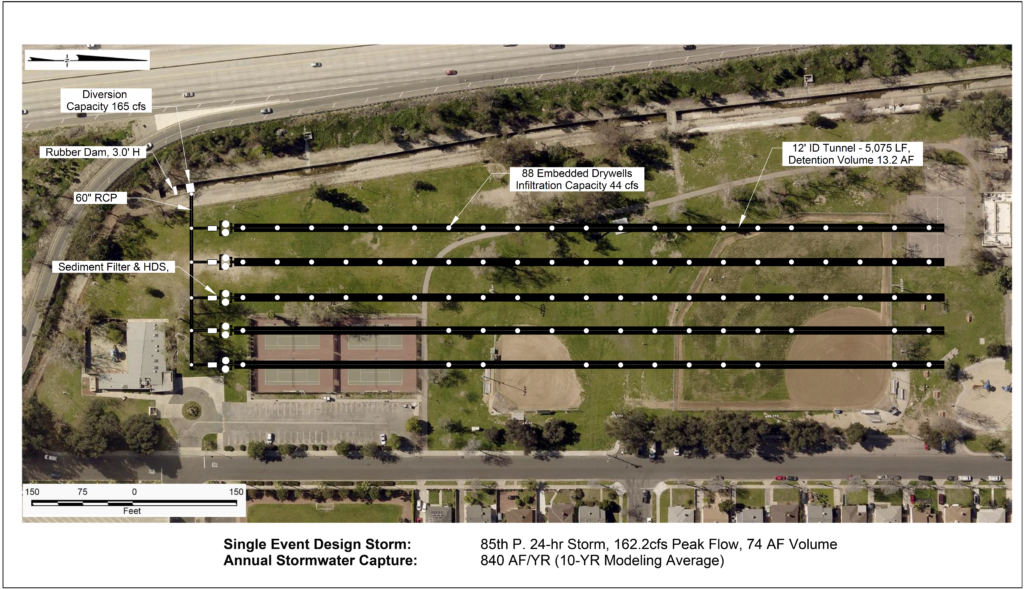
Proposed StormTunnel Alternative
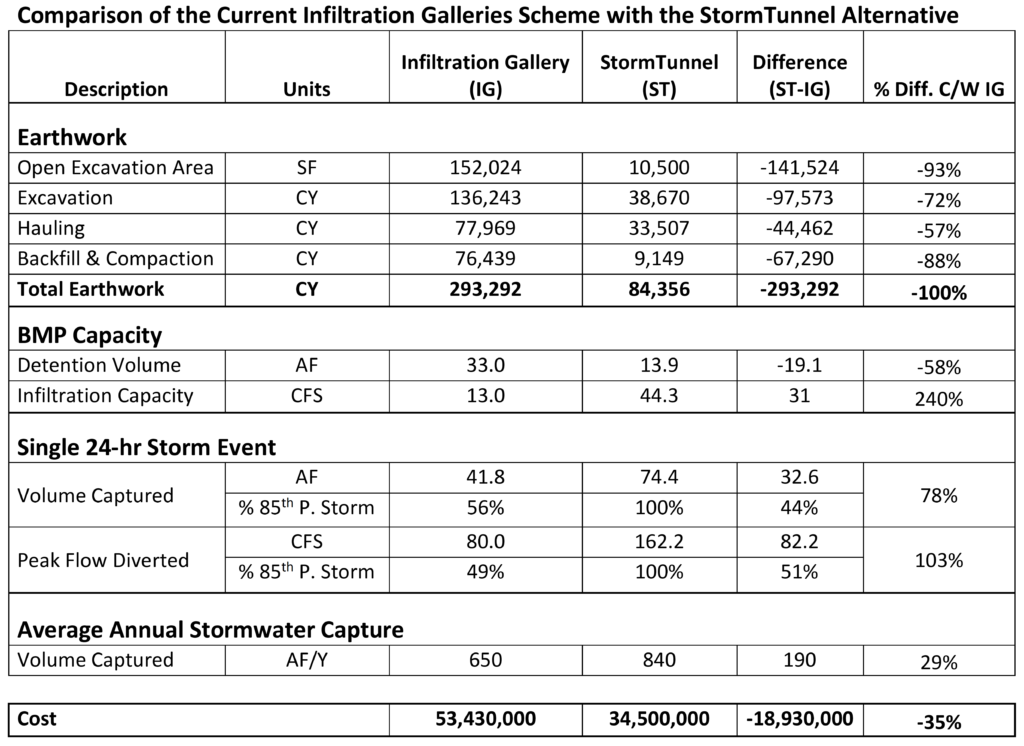
David M. Gonzales Recreation Center Stormwater Capture Project, Los Angeles Department of Water and Power
Current Scheme:
The current BMP scheme consists of the following elements:
- Two diversion structures; one on a 63" and the other on 84" storm drain.
- 935 LF of 36" pipeline.
- Two hydrodynamic separators receiving the diverted flows.
- Two sedimentation basins following the hydrodynamic separators.
- Two infiltration basins with total area of 114,000 SF (3.8 acres).
See Current Scheme Feasibility Study Report
Proposed StormTunnel Alternative:
The proposed StormTunnel BMP consist of the following elements:
- Same diversion and conveyance configuration as in current scheme.
- Sediment filter with parallel hydrodynamic separators for each diversion.
- Five parallel StormTunnel at 50-ft spacing receiving the pretreated water at opposite ends.
- Total combined StormTunnel length of 2,825 LF, with detention volume of 7.3 AF.
- 60 embedded drywells at 50-ft spacing with combined infiltration capacity of 24.5 cfs.
See David M. Gonzalez StormTunnel Plans
Advantages of the StormTunnel Alternative:
The proposed StormTunnel Alternative offers the following advantages over the current scheme:
- Open excavation of about 11,000 SF versus 1144,000 SF (90% less)
- Total earth work volume of about 64,000 CY versus 220,000 CY (71% less)
- Captures average of 840 AF/YR versus 6502 AF/YR i.e. 190 AF (29%) more
- Practically no park closures during construction versus complete closure of large areas
- Minimum public impact during construction because of reduced open excavation and earthwork quantities
- Practically no electrical work versus extensive electrical work for a pump station
Project cost of $28.5 vs. $39.12 Million ($10.62 Million, 27% less)
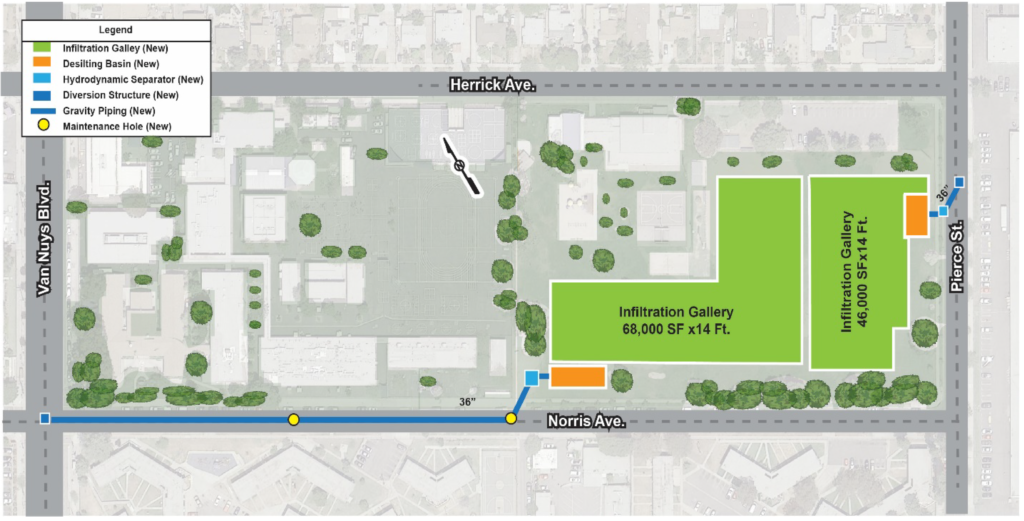
Current Scheme using Infiltration Galleries
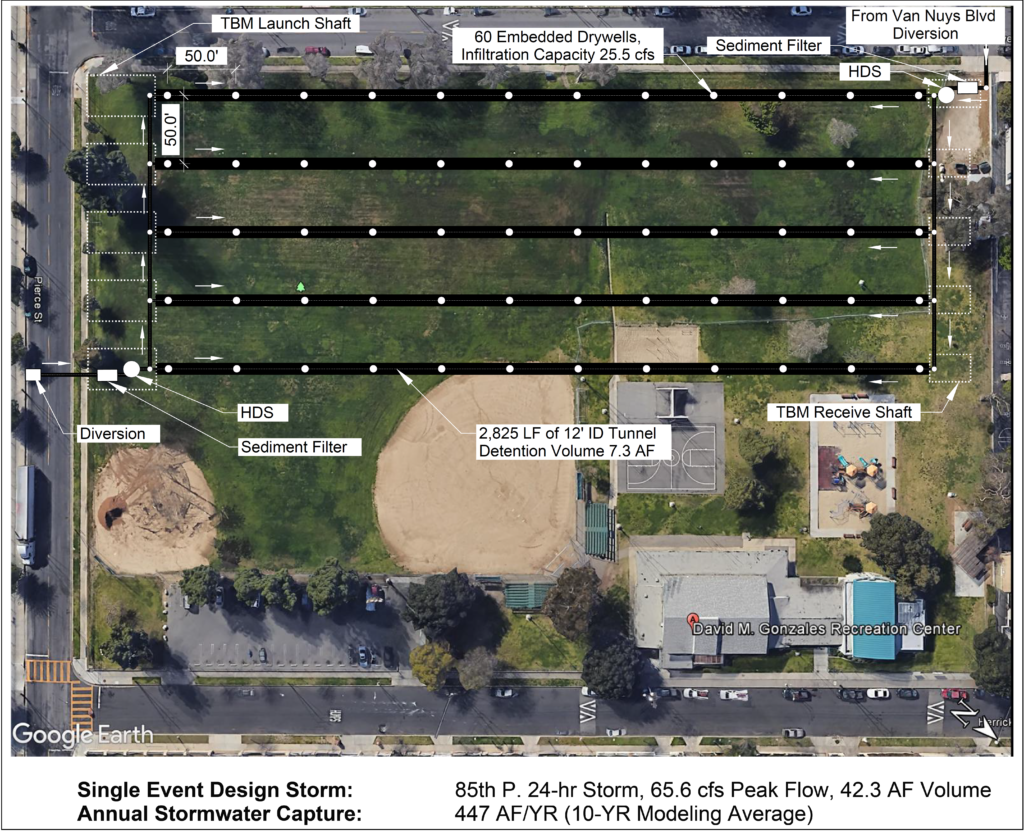
Proposed StormTunnel Alternative
